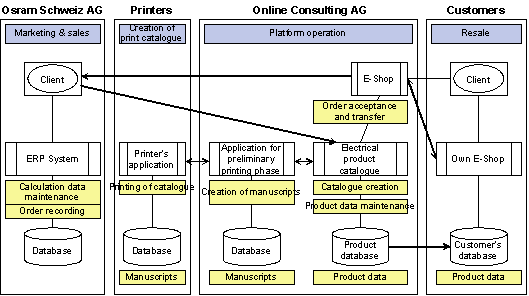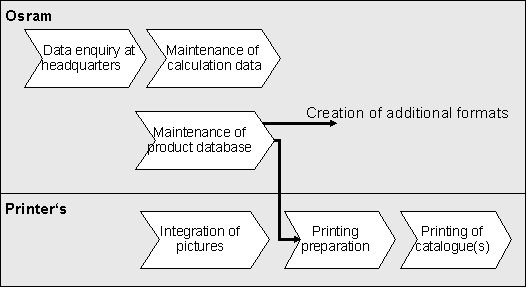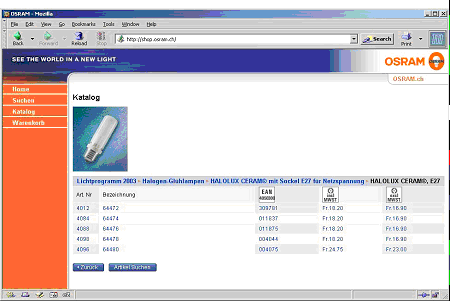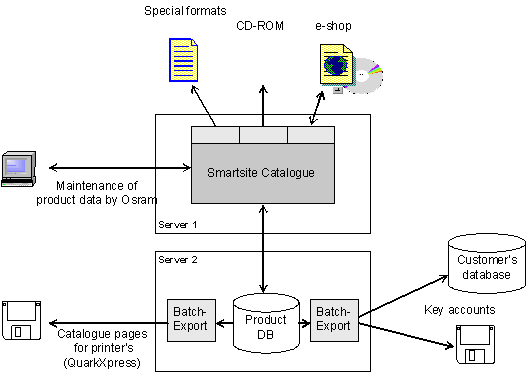The electronic product database of Osram AG as the basis for the electronic product catalogue
Osram AG in Winterthur sells Osram light sources and the electronic accessories for these in Switzerland. The focal point of the solution described here is the development of a central product database and the crossmedial creation of a product catalogue for print, e-shop, CD-ROM and various special formats. External integration for the exchange of product datas with a few key accounts also takes place. The excellently functioning system stands out due to a fast ROI.
Inhaltsverzeichnis
1. The company2. E-Business strategy
3. Integration solution
Product database, business perspective, process view, application view, electronic product catalogue, catalogue export, technical view
4. Implementation
5. Operation
Maintenance, costs and benefits, profitability
6. Success factors
1. The company
Background:
Osram AG, which is based in Winterthur, belongs to the Osram Group, which is in turn part of the Siemens Corporation. The German company Osram GmbH, which is based in Munich, is the Group’s headquarters. The corporation has a strong international orientation and has a workforce of approximately 35,000 worldwide. The turnover is approximately €4.5 billion per year. Thus, Osram is the largest bulb manufacturer for car lights and the second largest bulb manufacturer in the world for general lighting.
The Osram headquarters supplies 57 affiliated companies and sales centres in 96 countries, including the swiss Osram AG. A further 50 countries are served by local representative offices of Osram Munich.
The individual affiliated companies have their own marketing and sales operations for the respective region. They buy products with sometimes differing conditions from the headoffice in Germany. The sales conditions, such as prices and discounts on Osram products, are set by the regional affiliated companies, and therefore in Switzerland this is Osram AG. The affiliated companies have no significant influence on production. The delivery of ordered products is carried out for Switzerland by a logistics centre in Germany, namely in Augsburg.
Industry sector, product and target group:
Osram produces and sells light sources and the accompanying electronic items for each application. The product spectrum of Osram comprises light sources for general and vehicle lighting and for photo, film, TV, stage and optics, electronic control gear and optoelectronic semiconductors. The corresponding range includes lamps for all kinds of fields of application: from private households and sports stadiums to sales areas and production halls. Up to now light sources and especially the general lighting arm accounted for the main share in turnover, although by 2005 the share of the electronics arm is supposed to increase to 50% of the turnover. 40% of the total turnover of the Osram Group is generated by products which are less than five years old, which shows that Osram is concentrating on forward-looking products and innovations.
Osram AG mainly supplies products to the intermediate trade, i.e. B2B. The specialist trade (both wholesale and retail trade) in addition to light manufacturers and the self-service trade account for the majority of sales. In terms of end users, the share of private customers is 60% and 40% of products sold are used commercially.
The key instrument for selling products is the main catalogue, for whose creation high layout standards have to be met. The printed catalogue comprises approximately 400 pages with 2,500 products; different technical details are required per product type (250). There are two language versions, namely German and French. The creation of a mini catalogue (price list) and various special formats are also necessary.
2. E-Business strategy
Importance of E-Business in corporate strategy:
The starting point for entry into E-Business was a necessary cost reduction with regard to creation of the print catalogue. The strategy can be summarised in order of importance by the following three points:
- Improvement in the manufacture of the print catalogue
- Crossmedia: generation of additional formats
- E-Shop as an additional sales channel
An E-Shop was therefore not the main motivation for the described solution, but evolved more as a “by-product“ when the process for creating the print catalogue was reorganised.
Nevertheless, one of the present goals of Osram Switzerland is to process as much as possible via the E-Shop. Compared to orders by telephone or fax, the customer benefits from more precise information and Osram from savings in the acceptance, recording and processing of orders.
E-Business fields of application within the company:
Osram’s requirements of an electronic product catalogue are especially:
- Generation and updating of catalogues in various media, especially print catalogue and electronic media (CD-ROM, Internet) with extendibility to the E-Shop and therefore simplification of the order
- Faster update cycles for products and prices
- Possibility of offering comprehensive and additional information through the E-Business solution
- Electronic product catalogues in different formats for special customer groups and key accounts, in order to satisfy increasing requirements from the E-Procurement of key accounts
Partners:
Business partner
Meier, a printers in Schaffhausen, is a long-standing partner of Osram Switzerland as regards the creation of printed matter, especially the main catalogue.
IT partner
Online Consulting AG, with over 40 employees, is one of the largest Internet service providers in eastern Switzerland with headquarters in Wil (SG). Online Consulting AG covers the areas of consulting, web design, publishing, software development, network technology and project management.
Contact with Online Consulting came about via the printing firm Meier, as Online Consulting had already worked with the printers on other projects. In the course of the project Online Consulting AG was chosen as the IT partner for the solution described here.
Key accounts
In addition to many larger and smaller intermediate dealers, there are a few important key accounts, with whom data is already is already being exchanged electronically, including supraregional and regional electrical specialised wholesalers and end users from the public sector.
3. Integration solution
Fig. 3.1 shows an overview of the integration solution. The focal point is the development of a central product database for the crossmedial creation of catalogues and the use of product data for an E-Shop. At the same time, external integration with a few key accounts also takes place.

Fig. 3.1: Overview of the solution
Business perspective:
The starting point for the E-Business solution was the wish to make creating the product catalogue in collaboration with the printers work significantly more efficient. As the product data is now managed by a central office and the layout master is easier to create and can be supplied in better quality, considerable time and money is saved compared to the original processes for preparing layout and the manuscript.
Catalogue excerpts are produced periodically for a few customers from the electronic product catalogue in the required formats.
In addition to the electronic product catalogue, an E-Shop is operated. 90% of orders from the specialist trade are already received electronically via an e-mail generated from the shop.
Process view:
The process for including a new product (product launch) in the sales catalogue of Osram Switzerland, which, for example, stems from a customer enquiry, is as follows (cf. Fig. 3.2). To start with, it is necessary to enquire about product data at Osram Germany. Then calculation data is transferred, such as, e.g., the purchase prices of products, into the ERP system of Osram AG. Parallel to this, the marketing data for the catalogue is maintained, it contains article information, technical descriptions, etc. The sale price and other marketing data are maintained separate to the ERP system via a web-based interface in the electronic product catalogue. The modification of an existing product, e.g. the amendment of the sale price, is carried out analogously, thus omitting, where applicable, the “headoffice data enquiry”.

Fig. 3.2: Process for creating the catalogue
After maintaining the product database, no further steps are necessary for the provision of products in the E-Shop. To process orders from specialist dealers in the E-Shop, an e-mail is sent to Osram, but no integration with the ordering system takes place.
The pictures for integration in the print catalogue come from Osram and external agencies and are managed directly by the printers.
Application view:
Electronic product catalogue
The focal point of the solution is the operation of a central product database, which contains all the necessary product data for the various marketing instruments.
The product database has no integration to the ERP system of Osram. Maintenance of data is carried out by the product manager via a web-based interface. Here, all technical data, pictures, additional information such as text files, etc. can be changed. Any desired cross references are also possible, e.g. cross-selling of products or accessories, i.e. the connection of appropriate accessories to products. Prices can be deposited in different currencies for the e-shop.

Fig. 3.3: E-shop application
Creation of external formats
Target formats for the catalogue application are:
- Direct creation of print catalogue pages in QuarkXpress format for the printers. Here, additional pages which are not based on the product database (e.g. cover pages) from existing catalogues can be easily integrated and processed in the format normally used by the printers. This is a function of the product catalogue application.
- Catalogue and ordering system for the Internet (shop.osram.ch) and CD-ROM. The following functions are available to the user:
- Display of articles with list price and technical data
- Display of alternative products (cross selling)
- Search according to various criteria
- Compilation of a shopping basket (order list)
- Additional shopping basket functions are provided for registered specialist dealers to process orders. Here, an email is sent to Osram, but no integration with Osram’s ERP system.
- Various special prints in QuarkXpress format, e.g. a product range list for the automotive industry
- Export for two key accounts
The database supplies all contents required to create the catalogue pages. By means of an intelligent interface, the data is automatically incorporated into finished catalogue pages specifically for each article group. Two index pages (according to article number and according to e-number) and the table of contents per chapter are therefore created automatically and in an error-free way. As soon as new data is available, both individual pages and the whole catalogue can be recreated (e.g. price adjustments or new products on individual pages).
Internal integration with the ERP system
It was decided not to Integratie the E-Business solution with the existing ERP system of Osram AG or the system of the group holding company. The plan is to interate the (proprietary) ERP system of Osram AG with the SAP system of the holding company in Germany by 2005.
The solution described here is a stand-alone solution as far as integration goes. This decision facilitated an application which was low in terms of costs, quick to implement and independent from the current legacy system.
External integration with customers
The external integration which now takes place with two key accounts is carried out as a batch export from the product database. In doing so, some basic article information and references to detailed pages in the Osram E-Shop are prepared for the wholesalers. The article information is integrated into the database of these customers’ shops. When detailed information about an article is accessed, an HTML page is generated by the Osram E-Shop, which is inserted in the customer’s E-Shop. Integration therefore takes place at both data and application level (cf. Fig. 3.1)
The interface to an additional key account is achieved by exporting the product data as a text file to data carriers in UN/SPSC format (as a .csv file). At the present time, a generally defined interface is not provided for these kinds of catalogue exports; transfer is organised individually for each customer in line with the customer’s specific requirement.
The pictures of the products for the E-Shop and the print catalogue come from various sources, namely from Osram Germany, from external agencies and Osram Switzerland, as these companies also create pictures of the products themselves. The product photos are already supplied in a web-compatible format so that they can be electronically processed for the E-Shop.
Technical view:
The application is based on the Smartsite Catalogue product of Online Consulting (Fig. 3.4).

Fig. 3.4: Technical view
The product catalogue for Osram was realised with Microsoft .NET technology, which allows such applications to be implemented quickly. The product is structured according to a multilayered system, known as multi-tier architecture:
- Presentation tier: complete browser solution with HTML, JavaScript and ASP.NET
- Application tier: object-oriented module in C#
- Database product DB: Microsoft SQL server
The CD-ROM solution corresponds exactly to the E-Shop. For this, static HTML pages are generated for offline use from the dynamically created web pages and stored on the CD-ROM. JavaScript is used for dynamic functions, such as to provide a shopping basket. In the case of the CD-ROM solution, a Microsoft Word document is generated to carry out an order.
The software solution is an application from Online Consulting with standard components, using the Smartsite Catalogue catalogue system from Online Consulting. The alignment with XML creates a high level of flexibility with regard to interfaces in addition to structured data storage.This meant that development costs and maintainability could be highly optimized.
Texts for product descriptions or similar items are stored in the product database in a neutral format. The pictures are saved in a strictly defined format (e.g. Osram web quality). All other picture formats are managed by the printers. If other picture formats are required for a specific medium, these can be requested and automatically integrated for the appropriate output by means of a clear key.
For batch export, files are created from the catalogue system which are then sent to the printers or the key accounts for further processing.
The system is operated on two Microsoft Windows 2000 servers (cf. Fig. 3.4).
4. Implementation
The project came about after Osram had enquired of Meier printers about the possibility of reducing the considerable costs for the print catalogue. To achieve this, Online Consulting was called in to replace the manual preparation of printed pages with a modern, database-aided catalogue system.
The product database was built up by exporting data from the Osram ERP system in a one-off operation. Data was then integrated from an existing CD-ROM solution and data stocks into the printers system.
The solution has been up and running since September 2002.
5. Operation
Maintenance:
The product database and the complete application run on two servers at Online Consulting, who is therefore not just responsible for providing the solution, but is also in charge of its operation. Maintenance of data in the product database is carried out by the Osram Product Manager via a web-based interface.
Costs and benefits:
Costs were incurred through the investment in the database-supported solution to create the catalogue and additional formats. These were offset by the savings achieved for production of the print catalogue. As a result of the described application, the manual preparation of the catalogue pages could be reduced by 90%, whereby a considerable cost saving was achieved.
The processing of orders could be significantly improved through the increased use of electronic media. The specialised trade already orders 90% of goods via the E-Shop, which has also led to a considerable cost saving for order processing even without (direct) integration with the Osram ordering system, as data such as order numbers is already available in a structured and checked form, in contrast to an order by telephone or fax.
Customer feedback is also very positive. The E-Shop solution is lauded as a very user-friendly, fast and clear system. The electronic catalogue corresponds exactly to the print catalogue, so that customers can easily find their bearings. The standardisation of the catalogue due to the build-up of the product database is therefore also a very positive feature for the end user.
Profitability:
Osram is very satisfied with this solution. An ROI for the whole investment is already expected with the second run, i.e. the second preparation of the print catalogue using the described solution. This will be achieved by a reduction in costs during the preliminary stages of printing alone. The additional formats and the E-Shop could also be achieved within the scope of the project.
This solution has therefore become very important for Osram within a relatively short time after its launch and Osram could no longer imagine operations without it.
6. Success factors
Specialities of the solution:
A special feature of the solution is definitely the crossmedial and Internet-aided approach to creating the catalogue in various formats. By building up a central product database and through the multiuse of data, considerable cost savings could be achieved.
This also shows that complete integration of a company’s ERP system does not have to take place when an E-Business solution is launched and that significant improvements can still be achieved through the systematic processing of data which was previously maintained manually and an efficient stand-alone solution.
Changes:
Advantages
In summary, the following improvements could be achieved by implementing the described solution:
- Reduction in costs for preparation of the print catalogue by cutting the workload for printing preparation
- Organisational improvements through the multiple use of product data for the print catalogue, Internet shop, CD-ROM and special needs of key accounts instead of the manual maintenance of printed pages
- Maintenance of the data in a central database and thus also the guarantee that data is up-to-date
A further point is that the quality of the E-Shop and the CD-ROM could be significantly improved. In an initial version PDF files of catalogue files were used, which was not very user-friendly for the customers and led to corresponding queries.
Difficulties
One problem which affected implemenation of the solution was the hitherto strong orientation towards the main catalogue. Each amendment against this reference is difficult and has major repercussions, especially concerning cooperation with the printers.
The initial creation of the product database was relatively time-consuming, too, as no complete data source existed for this.
Lessons learned:
The interesting feature of this E-Business solution is that the E-Shop and a database-supported product management system were not planned as the main target at the start of the project, but this could be achieved in addition to reduced costs for creating the print catalogue. The basis for a more intensively automated catalogue creation system could be created, promising flexibility and further advantages for Osram in the future, e.g. with respect to additional requirements of key accounts.
It was decided not to carry out stronger integration with the Osram’s ERP system in favour or an E-Business solution that was fast to implement and efficient, which led to a fast ROI. On the other hand, problems also arose due to the necessary manual matching of product data, as in the case of an error, e.g. the prices used in the E-Shop may deviate from the prices in the ERP system, which leads to additional costs for processing orders.
The costs of maintaining the contents should not be underestimated. The staff in charge are confronted with new requirements which are caused by the multiple use of data. The existing editing process with prior deletions and corrections is replaced by maintenance of data in an Internet application/database. The increased workload of key personnel who are responsible for contents due to the conversion of this process must be taken into account.




